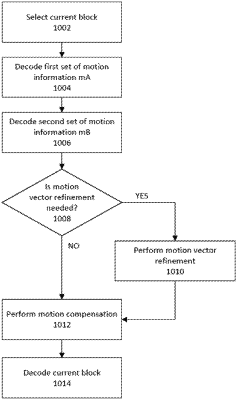| CPC H04N 19/513 (2014.11) [H04N 19/577 (2014.11)] | 28 Claims |

|
1. A method, performed by a decoder, for decoding a current block in a current picture of a video bitstream, the current picture having a current picture order count, the method comprising:
decoding, from the video bitstream, a first motion vector for the current block relative to a first reference block of a first reference picture having a first picture order count;
decoding, from the video bitstream, a second motion vector for the current block relative to a second reference block of a second reference picture having a second picture order count, wherein the first and second motion vectors each comprise a three-dimensional motion vector including an x-component in a plane of the current picture, a y-component in the plane of the current picture and a z-component, wherein the z-component represents a time component;
determining whether to refine the first motion vector based on comparing a difference between the z-components of the first and second motion vectors to a third threshold, and determining to refine the first motion vector in response to the difference between the z-components of the first and second motion vectors being less than the third threshold;
responsive to determining to refine the first motion vector, generating a first refined motion vector from the first motion vector; and
performing motion compensation to derive an updated first reference block from the first reference picture using the first refined motion vector.
|